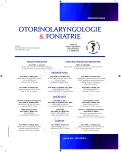Late Post-Intubation Pneumomediastinum and Cervical Emphysema
Authors:
M. Waloszková 1; Richard Salzman 1
; R. Uher 2; P. Chrapková 1; I. Stárek 1
Authors‘ workplace:
Otolaryngologická klinika LF UP a FN Olomouc
; přednosta prof. MUDr. I. Stárek, CSc.
Klinika anesteziologie, resuscitace a intenzivní medicíny FN Olomouc
1; přednosta doc. MUDr. M. Adamus, Ph. D.
2
Published in:
Otorinolaryngol Foniatr, 62, 2013, No. 3, pp. 132-135.
Category:
Case History
Overview
Post-intubation pneumomediastinum and subcutaneous emphysema of the neck is a recognized complication of endotracheal tube insertion. This rare complication requires surgeon’s attention as it could result in a life-threatening condition. The air usually leaks firstly to mediastinum and then to the subcutaneous tissues of the neck through laceration in tracheal mucosa. The growing emphysema of the neck usually manifests straight after faulty intubation or shortly after extubation in cases when endotracheal tube cuff sealed the tracheal wall defect. The diagnosis is confirmed by the CT examination, which reveals an air in mediastinum and soft tissues of the neck. In large defects planned for surgical repair, bronchoscopy is the method of choice for precise localization and description of the extent of the tracheal mucosal defect. The therapy is determined by the extent of the tear and clinical state of patient.
Authors present a rare case of late postintubation pneumomediastinum and subcutaneous emphysema of the neck. The delayed manifestation was probably caused by primarily non-penetrative intubation injury. The area of weakened tracheal wall probably ruptured as a result of increased intrathoracic pressure during the cough or defecation. The discussion covers etiology, diagnostics as well as treatment suggestions of this iatrogenic complication.
Keywords:
pneumomediastinum, subcutaneous emphysema, intubation, tracheal laceration
Sources
1. Alagöz, A. et al.: Two cases of tracheal rupture after endotracheal intubation. Letters to the editor., 10, 2007, s. 1053.
2. Borasio, P., Ardissone, F., Chiampo, G.: Post-intubation tracheal rupture. A report on ten cases. Eur J. Cardio-Thor. Surg., 12, 1997, s. 98-100.
3. Conti, M., Pougeoise, M., Wurtz, A., et al.: Management of postintubation tracheobronchial ruptures. Chest. J., 130, 2006, 2, s. 412-419.
4. Fan, K. P., Kun, W. M., Tung, W. K.: Spontaneous pneumomediastinum- An uncommon disease presenting as a common complaint. Honk Kong J. of Emerg. Med., 7, 2000, 1, s. 42-45.
5. Goette, A., Binias, K. H., Schenkengelb, J. P.: Pneumomediastinum, subcut. emphysema and respir. arrest after ‘‘mediastinal intubation“. Resuscitation, 72, 2006, s. 340-341.
6. Gries, C. J., Pierson, D. J.: Tracheal rupture resulting in life-threatening subcutaneous emphysema. Resp. Care, 52, 2007, 2, s. 191-195.
7. Chang, Y. N., Lee, J. CH., Chen, J. J. et al.: A rare complication after microlaryngeal surgery: Subcutaneous emphysema and pneumomediastinum. Chin. Med. Asoc., 73, 2010, 5, s. 268-270.
8. Chen, E. H., Logman, Z. M., Glass, P. S. A. et al.: A case of tracheal injury after emergent endotracheal intubation: A review of the literature and causalities. Anesth. Analg., 93, 2001, 1270-1271.
9. Kaslow, O. et al.: Anterior chest discomfort and right neck pain in a young woman 2 days after an appendectomy. Journal of Cardiothoracic and BASF. Anaest., 24, 2010, 3, s. 519-522.
10. Massard, G., Rouge, C., Dabbagh, A. et al.: The tracheobronchial lacerations after intubation and tracheostomy. Annals of Thoracic Surgery, 61, 1996, 5, s. 1483-1487.
11. Möller, G. M., Berge, E. J. F. M., Stassen C. M.: Tracheocele: a rare cause of difficult endotracheal intubation and subsequent pneumomediastinum. Eur Respir. J., 7, 1994, s. 1376-1377.
12. Newcomb, A. E., Clarke, C. P.: Spontaneous pneumomediastinum: A benign uriosity or a significant problem. Chest., 128, 2005, 5, s. 3298-3302.
13. Paluszkiewicz, P. P., Bartosinski, J., Rajewska-Durda, K. et al.: Cardiac arrest caused by tension pneumomediastinum in a boerhaave syndrom patient. Ann. Thorac Surg., 87, 200, s. 1257-1258.
14. Pecellín, I. D., Valencia, J. P. G., Rodríguez, M. G.: Archivos de bronconeumologia. management of postintubation. Tracheal Rupture in Pediatric Patients., 45, 2009, 5, s. 257-261.
15. Rousie, C., Van Damme, H., Radermecker, M. A. et al.: Spontaneous tracheal rupture: A case report. Acta Chir. Belg., 104, 2004, s. 204-208.
Labels
Audiology Paediatric ENT ENT (Otorhinolaryngology)Article was published in
Otorhinolaryngology and Phoniatrics

2013 Issue 3
Most read in this issue
- Vestibular Migraine in the Otorhinolaryngologist's Out-patient
- Late Post-Intubation Pneumomediastinum and Cervical Emphysema
- Nocardia abscessus – Unusual Source of Nasal Inflammation
- Chondrosarcoma of Cricoid Cartilage
